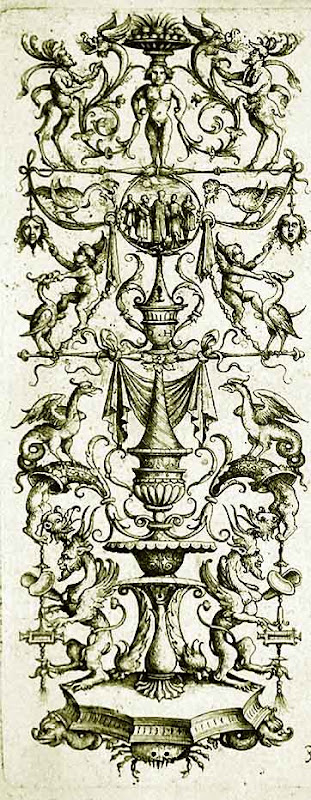Gothic manuscript illumination. Zebo da Firenze: Grotesque Flutist. Oxford, Bodleian Library, MS Douce 144, France, 1408, fol. 28v

Giovannino de Grassi, Gothic letters after a model book c. 1390, oil painting. Biblioteca Civica, Bergamo
Woodcut Initial "L" from Les Contenances de la table: petit traité des manières de table à l'usage des enfants, Lyon, c. 1490-1500, f. 2. Ref. booklet with instructions on table manners for children.
Majolica Dish with Grotesques in Raphael's manner (Piatto a raffaellesche), Faenza, 16th century. Museo internazionale delle ceramiche, Faenza

Italian Renaissance pilaster with grotteschi, candelabrum arrangement. Chiesa Madre di Erice, Sicilia (geo8_ipernity)

Giorgio Andreoli, Dish with Grotesques (Piatto a grottesche), maiolica, Gubbio, c. 1525. Museo internazionale delle ceramiche, Faenza
Italian Renaissance Dish with Candelabrum and Grotesques (Piatto con candelabre e grottesche). Ceramic. Museo Estense, Modena
Daniel Hopfer, Ornamental fillet with grotesques, engraving, c. 1530
Claude Paradin, "In Utrumque Paratus," emblem from Devises héroïques (1551), Lyon, 1557. Division of Rare and Manuscript Collections, Cornell University Library. One hand holds a sword, the other a trowel; the motto, In Utrumque Paratus, means "Ready for both." In emulation of the Kings of Israel in the Bible, modern Kings must be both warriors destroying enemies of their nation, as well as builders who regenerate and embellish their realm (Warriors and Builders: The Valois Kings as Patrons).

Joos van Craesbeeck, The Temptation of St. Anthony, 1650 (Uncultural).

Jean Le Pautre, Ornamental Hybrids, 17th century. Oeuvres d'Architecture de Jean Le Pautre, Architecte, Dessinateur & Graveur du Roi, Paris: Charles-Antoine Jombert, 1751, vol. 1 (Universitätsbibliothek Heidelberg)
Foliate grotesque. Green Man, architectural detail, c. 19th century. British Columbia, Canada (Amie Roman).
Grotesque. Biltmore House, Asheville, NC., 19th century
Marre Moerel, Transfigurations, porcelain, 2008. From left to right and top to bottom: Bitch in Heat, Geb the Great Cackler, Son of Sphinx, Sexy Beast, El niño elefante (The Elephant Child), and Chicken Boy Grew an Arm (Delicate Monstrosities).
Dan Hillier, Lovers, Mother, Weird Uncle Peter, Child, and Father, etching collage, 2006-10 (Boingboing, Null, Precursor, Randomindex, Zoodisk)
Ibid., Icarus, remixed woodcut, 2010 (Boingboing)

Alfred Kubin, Every Night We are Haunted by a Dream (Jede Nacht besucht uns ein Traum), ink and wash, c. 1901-3 (New York Times; see also Mapping the Shadowy Corners of the Subconscious).




























2 comments:
Dear Sir,
I wonder if you could tell me what is the main iconography of the mosaic that includes the human-foliate hybrids in the first two pics. Is it a bachic scene?
Thank you very much.
This post is about HYBRIDS IN ART. The point is to show the double-edged motifs and marginal imagery of the illustrated mosaic, not the myth that might possibly be depicted below (and which is not visible in the available photograph). While your idea sounds reasonable, and you may be quite right in thinking so, the only answer to your question is: depart from the data available here and go ahead researching the topic. Good luck :)
Post a Comment